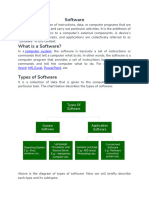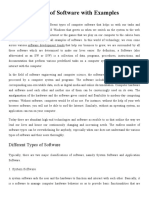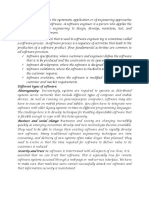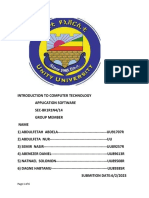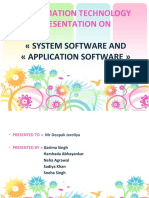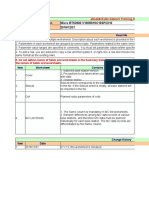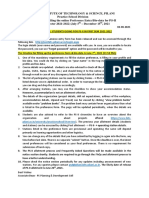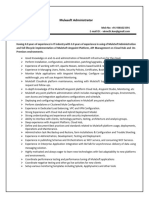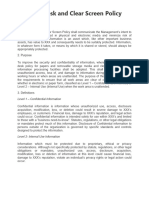Computer - Software Types
Software is a collection of programs, data, and instructions that enable a computer system
and its hardware’s to do the tasks. A program is a set of instructions or programming
statements.
Hence, software built using multiple statements. It is an important part of modern
computing and is classified into different categories based on its capability and purpose.
For example, word-processing software enables the user to create, edit and save
documents. A web browser enables the user to view and share web pages and multimedia
files.
Software Types
Some common types of software are as −
System Software
Application Software
Utility Software
Open Source Software
Fig: Software and its types
System Software
Software that enables a computer to run and activates required hardware or other parts of
a computer to run is called system software. System software acts as interface
between hardware and user applications. An interface is needed because hardware devices
or machines and humans speak in different languages.
Machines understand only binary language i.e. 0 (absence of electric signal) and 1
(presence of electric signal) while humans speak in English, French, German, Tamil, Hindi
and many other languages. English is the pre-dominant language of interacting with
computers.
Software is required to convert all human instructions into machine understandable
instructions. And this is exactly what system software does.
Based on its function, system software is of four types −
Operating System
Language Processor
Device Drivers
Operating System
Generally, system software is responsible for functioning of all hardware parts and their
interoperability to carry out tasks successfully is called operating system (OS).OS is the
first software to be loaded into computer memory when the computer is switched on and
this is called booting.
OS manages a computer's basic functions like storing data in memory, retrieving files from
storage devices, scheduling tasks based on priority, etc.
Language Processor
As discussed earlier, an important function of system software is to convert all user
instructions into machine understandable language. When we talk of human machine
interactions, languages are of three types −
Machine-level language − This language is nothing but a string of 0s and 1s that
the machines can understand. It is completely machine dependent.
Assembly-level language − This language introduces a layer of abstraction by
defining mnemonics. Mnemonics are English like words or symbols used to denote
a long string of 0s and 1s. For example, the word "READ" can be defined to mean
that computer has to retrieve data from the memory. The complete instruction will
also tell the memory address. Assembly level language is machine dependent.
High level language − This language uses English like statements and is
completely independent of machines. Programs written using high level languages
are easy to create, read and understand.
Program written in high level programming languages like Java, C++, etc. is called source
code. Set of instructions in machine readable form is called object code or machine code.
System software that converts source code to object code is called language processor.
There are three types of language interpreters −
Assembler − Converts assembly level program into machine level program.
Interpreter − Converts high level programs into machine level program line by
line.
Compiler − Converts high level programs into machine level programs at one go
rather than line by line.
Device Drivers
System software that controls and monitors functioning of a specific device on computer is
called device driver. Each device like printer, scanner, microphone, speaker, etc. that needs
to be attached externally to the system has a specific driver associated with it. When you
attach a new device, you need to install its driver so that the OS knows how it needs to be
managed.
Application Software
Application software, sometimes known as "apps" or "applications," is a type of software
that is created for certain tasks or functions such as productivity, entertainment,
communication, or other reasons. Hence, software that performs a single task and nothing
else is called application software. Application software is very specialized in their
function and approach to solving a problem. So spread sheet software can only do
operations with numbers and nothing else. Application software, as opposed to system
software (such as operating systems and device drivers), is designed to fulfil the needs
and preferences of end users. The following are some examples of common types of
application software −
Productivity Software
Word Processing − This application software allows users to create, edit, and
format documents. Some popular word processing applications are Microsoft Word,
Google Docs, and Apple Pages.
Spreadsheet Application − This application software is used to create and
analyzing spreadsheets. Some popular Spreadsheet applications are Microsoft
Excel, Google Sheets, and LibreOffice Calc.
Presentation Software − This application software is used to make slideshows
and presentations. Some popular presentation applications are Microsoft
PowerPoint, Google Slides, and Apple Keynote.
Project Management Software − This application software is used to make
teams plan, organize, and track projects. Examples - Trello, Asana, and Jira.
Calendar and Scheduling Apps − This application software is used for time
management and scheduling appointments, like Google Calendar, Microsoft
Outlook, and Apple Calendar.
Graphics and Multimedia Software
Image Editing − This application is used to edit and manipulate images.
Examples are Adobe Photoshop, GIMP, and Canva.
Video Editing − This application is used to create and editing of video. Examples
are Adobe Premiere Pro, Final Cut Pro, and DaVinci Resolve.
Audio Editing − This application is used for recording and editing audio. Examples
are Audacity and Adobe Audition.
3D Modelling and Animation − This application is used for creating 3D graphics
and animations. Examples are Blender and Autodesk Maya.
Communication Software
Email Clients − This application is used to send, receive, and manage email.
Examples are Microsoft Outlook, Mozilla Thunderbird, and Apple Mail.
Instant Messaging Apps − This application enables users for real-time text and
multimedia communication. Examples are WhatsApp, Slack, and Telegram.
Video Conferencing Software − This application is used to conduct virtual
meetings and conferences. Examples are Zoom, Microsoft Teams, and Cisco
Webex.
Social Media Apps − These applications provide platforms for social networking.
Examples are Facebook, Twitter, and Instagram.
Web Browsers
These application programs are used to access and navigate websites on the internet.
Popular web browsers are Google Chrome, Mozilla Firefox, Microsoft Edge, and Safari.
Gaming Software
These applications are designed for entertainment and gaming. Examples are Steam,
PlayStation, Xbox, and mobile app stores.
Utility Software
Provides various utilities to perform specific tasks, such as −
File Compression and Extraction − Examples are WinZip, 7-Zip, and WinRAR.
Backup and Recovery − Examples are Acronis True Image and Time Machine.
Disk Cleanup and Optimization − Examples are CCleaner and Disk Cleanup
(Windows).
Education and E-Learning Software
These applications are designed to learning management systems (LMS); automate
educational system, online education, and digital libraries.
Health and Fitness Apps
These applications are designed to keep track of health metrics, Yogas and Asans, dietary
guidance etc.
Financial Software
These applications are specifically designed to manage personal finances, accounting, and
taxation. Examples are QuickBooks, TurboTax, and Mint.
Travel and Navigation Apps
These applications are designed to assist travellers with trip planning, maps, and GPS
navigation etc. Examples are Google Maps, TripAdvisor, and Waze.
In continuation of changing demands and preferences of users in different fields,
application software continues to improve and diversify. Users can install and utilise these
applications to do certain tasks and enhance their digital experiences on their computers,
smartphones, tablets, and other digital devices.
Utility Software
Application software also known as utility programs or system utilities that assists system
software in doing their work is called utility software. Utility software is intended to help
users to manage and maintain their computer systems, as well as optimise performance
and execute different system-related activities. These programmes are often used to
assure the efficient operation of hardware and software components, and improve a
computer system's overall functionality and stability. Thus utility software is actually a
cross between system software and application software.
Some common types of utility are as −
Antivirus and Antimalware Software − These utilities keep safe the computer
against malicious software, spyware, and viruses, as well as other types of security
threats. Examples are Norton Antivirus, McAfee, and Malwarebytes.
Disk Cleanup and Optimization − These utilities help to remove temporary or
unwanted files. For example - CCleaner (Crap Cleaner) removes temporary files,
cache data, and unused files to free up disk space. Defragmentation applications
reorganise fragmented files on a hard drive in order to increase read/write access.
Disk Partitioning and Management − Disc Management (Windows) and GParted
(Linux) are utilities that enable users to create, resize, and manage partitions on
their hard drives.
Backup and Recovery − Backup utilities automatically create copies of vital data
to prevent loss. Example: Windows Backup and Time Machine (Mac). Data recovery
software recovers erased files and folders. Popular options include Recuva and
TestDisk.
System Monitoring and Diagnostic Tools − Task Manager (Windows) and
Activity Monitor (Mac) offer real-time system resource monitoring to find and fix
performance issues. Windows Memory Diagnostic and Apple Diagnostics (Mac)
diagnose hardware issues.
Driver Updaters − For hardware compatibility and performance, these
programmes update out-dated or incompatible device drivers. Examples are Driver
Booster and Driver Easy.
Password Managers − Users generate, store, and manage complex, secure
passwords with password management software. Examples are LastPass,
Dashlane, and 1Password.
Firewall Utilities − A firewall protects a computer or network by managing
incoming and outgoing network traffic. Examples are Windows Firewall and third-
party firewall solutions like ZoneAlarm.
Data Encryption Software − These utilities encrypt sensitive data to protect it
from unauthorized access. Examples are BitLocker (Windows) and FileVault (Mac).
Uninstaller Programs − These utilities assist users in thoroughly removing
undesirable apps as well as the files and registry entries linked with those
applications. Examples are Revo Uninstaller and IObit Uninstaller.
Open Source Software
Software whose source code is freely distributed with a license to study, change and
further distributed to anyone for any purpose is called open source software. Open
source software is generally a team effort where dedicated programmers improve upon
the source code and share the changes within the community. Open source software
provides these advantages to the users due to its thriving communities −
Security
Affordability
Transparent
Interoperable on multiple platforms
Flexible due to customizations
Localization is possible
Freeware
A software that is available free of cost for use and distribution but cannot be modified as
its source code is not available is called freeware. Examples of freeware are Google
Chrome, Adobe Acrobat PDF Reader, Skype, etc.
Shareware
Software that is initially free and can be distributed to others as well, but needs to be paid
for after a stipulated period of time is called shareware. Its source code is also not
available and hence cannot be modified.
Proprietary Software
Software that can be used only by obtaining license from its developer after paying for it is
called proprietary software. An individual or a company can own such proprietary
software.
Its source code is often closely guarded secret and it can have major restrictions like −
No further distribution
Number of users that can use it
Type of computer it can be installed on, example multitasking or single user, etc.
For example, Microsoft Windows is a proprietary operating software that comes in many
editions for different types of clients like single-user, multi-user, professional, etc.


